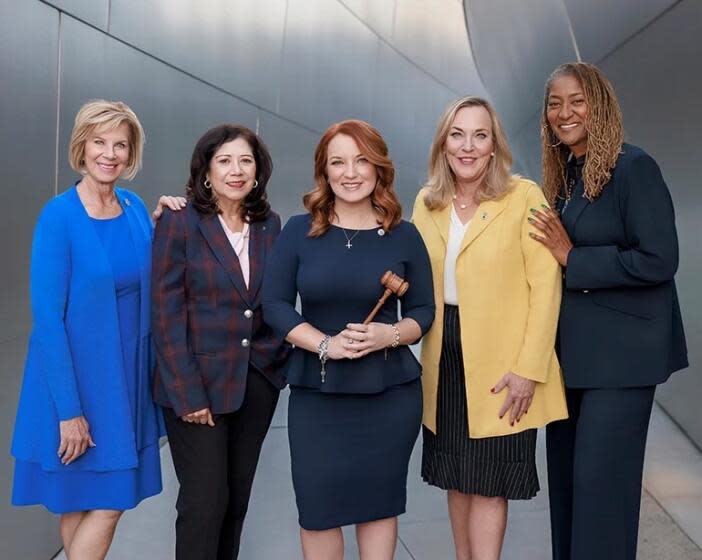Some L.A. County supervisors say proposed expansion of the board is rushed

A plan to reshape Los Angeles County government inched closer to the November ballot Tuesday, despite concerns from a minority of supervisors that the overhaul was rushed and haphazard.
In an unusually testy meeting, the supervisors voted 3 to 0 to direct county lawyers to draft an amendment to the county charter that would nearly double the size of the five-member Board of Supervisors and create an elected position to oversee day-to-day operations.
Supervisors Kathryn Barger and Holly Mitchell, who critiqued parts of the plan throughout the meeting, abstained from voting.
Supervisor Hilda Solis cast the decisive yes vote, joining the plan’s authors, Supervisors Lindsey Horvath and Janice Hahn, in moving it forward. Horvath and Hahn have said their aim is to make the government structure — fundamentally unchanged for over a century — more responsive to the county’s 10 million residents.
Each of the five supervisors oversees a district of about 2 million people. In 1912, when voters first adopted a charter, the ratio was one supervisor for every 50,000 people.
“I’ve always been of the opinion that we do need to have more representation,” Solis said.
Under the proposed charter amendment, the number of supervisors would increase to nine. The county chief executive, who oversees the budget and manages daily operations, would be elected by voters rather than appointed by the board. And the county would create an independent ethics commission to investigate corruption.
The amendment must come back to the board twice more for votes before appearing on the November ballot.
Barger and Mitchell delivered a series of pointed questions to their colleagues and two experts.
Why nine supervisors and not seven or 15?
Could a study be done to determine the right number?
Would having an elected executive turn the position partisan?
What would it take to fund the overhaul?
“I’ve got questions,” Mitchell said. "I just think there’s too much at risk for us to take a bite of the apple that’s not absolutely ideal.”
Barger unleashed some of the most biting criticism, saying she felt that county supervisors were plagued not by structural issues but rather by paralyzing indecision. She pointed to the long delays in closing Men’s Central Jail, a dilapidated facility that supervisors voted to shut down years ago. The problem there, she said at the meeting, was that the supervisors had “no will to make the tough decision” on what should replace it.
Both Barger and Mitchell also critiqued the process of formulating the ballot measure, which burst into public view last week with a news conference. Barger said she felt her colleagues had excluded Mitchell, who had brought forward two plans early last year — one successful, one not — to improve county government structure.
“This process was anything but transparent as it relates to how this was rolled out,” Barger said.
It was an unusually contentious meeting from supervisors who, at least publicly, like to agree — or disagree in the most gentle of terms.
“You’re really upset about this,” said Hahn, noting that she and Barger are usually aligned. “I feel it.”
Horvath and the experts she and Hahn had invited sought to alleviate some of the concerns, saying the proposal, while not a panacea, would probably make the government more responsive.
Fernando Guerra, director for the Center for the Study of Los Angeles at Loyola Marymount University, told the supervisors he had never heard of a jurisdiction with 10 million people not having an elected executive.
“It might not be perfect, and it might not meet the needs of all five members, but I maintain that this is the right thing to do,” Horvath told her colleagues.
Under the plan, the nine-supervisor structure would not start until 2032, following a redistricting process, which could give some racial and ethnic groups new political prominence, notably those in the often-overlooked unincorporated parts of the county.
Pomona College politics professor Sara Sadhwani, who served on the California Citizens Redistricting Commission, noted to the board that Rowland Heights and Hacienda Heights have large Asian American populations, while East Los Angeles has a significant Latino community, which could form powerful voting blocs depending on how the lines are drawn.
There has never been an Asian American county supervisor, and Solis is the only Latina on the all-female board, in a county that is nearly 50% Latino.
“These districts are so large that we have incredible dilution of various communities of color,” Sadhwani said.
Horvath’s office said the plan is for the final two votes on the charter amendment language to take place July 23 and Aug. 6.
The final board vote would have to happen before Aug. 9 for the amendment to make the November ballot.
This story originally appeared in Los Angeles Times.

 Yahoo News
Yahoo News 
